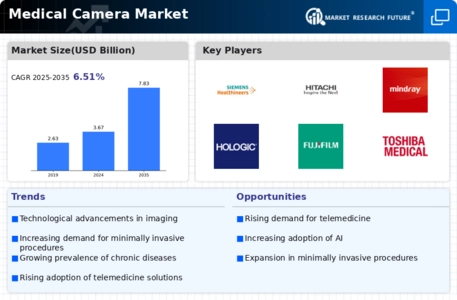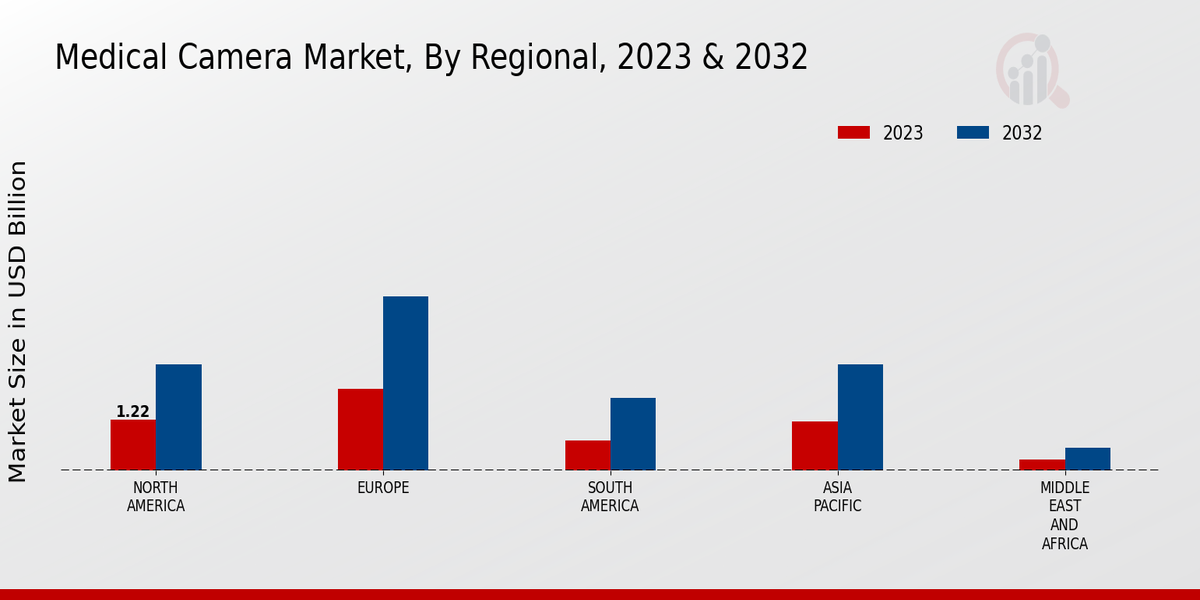Market Growth Projections
The Global Medical Camera Market Industry is projected to experience substantial growth over the coming years. The market is expected to reach 3.67 USD Billion in 2024 and is forecasted to expand to 7.83 USD Billion by 2035, reflecting a robust CAGR of 7.13% from 2025 to 2035. This growth is driven by various factors, including technological advancements, increasing demand for minimally invasive procedures, and a rising geriatric population. The market's trajectory suggests a promising future, with medical cameras becoming integral to modern healthcare practices.
Technological Advancements
The Global Medical Camera Market Industry is experiencing rapid growth due to continuous technological advancements. Innovations such as high-definition imaging, 3D visualization, and enhanced digital connectivity are transforming medical imaging practices. For instance, the integration of artificial intelligence in imaging systems is improving diagnostic accuracy and efficiency. As a result, the market is projected to reach 3.67 USD Billion in 2024, with a significant contribution from advanced imaging modalities. These advancements not only enhance patient outcomes but also streamline workflows in healthcare facilities, thereby driving the demand for sophisticated medical cameras.
Rising Geriatric Population
The Global Medical Camera Market Industry is significantly influenced by the rising geriatric population, which is more susceptible to chronic diseases requiring advanced diagnostic imaging. As the global population ages, the demand for effective medical imaging solutions is likely to increase. This demographic shift is expected to drive the market, as older adults often require more frequent medical evaluations and interventions. Consequently, the market is anticipated to grow at a CAGR of 7.13% from 2025 to 2035, reflecting the increasing need for medical cameras that cater to the diagnostic requirements of this population segment.
Expansion of Healthcare Infrastructure
The Global Medical Camera Market Industry is positively impacted by the ongoing expansion of healthcare infrastructure globally. As countries invest in upgrading their healthcare facilities, the demand for advanced medical imaging technologies, including medical cameras, is expected to rise. This expansion is particularly evident in emerging markets, where healthcare access is improving. The market is projected to grow significantly, reaching 7.83 USD Billion by 2035, as new hospitals and clinics are equipped with state-of-the-art imaging systems. This trend indicates a robust future for the medical camera sector as healthcare systems evolve.
Growing Focus on Early Disease Detection
The Global Medical Camera Market Industry is benefiting from an increasing emphasis on early disease detection and preventive healthcare. Healthcare systems worldwide are prioritizing early diagnosis to improve treatment outcomes and reduce healthcare costs. Medical cameras play a crucial role in this paradigm shift, enabling healthcare professionals to identify conditions at earlier stages. The market's growth trajectory is supported by the anticipated rise to 3.67 USD Billion in 2024, as healthcare providers invest in advanced imaging technologies to enhance their diagnostic capabilities. This focus on early detection is likely to continue driving demand for medical cameras.
Increasing Demand for Minimally Invasive Procedures
The Global Medical Camera Market Industry is witnessing a surge in demand for minimally invasive procedures, which rely heavily on advanced imaging technologies. As healthcare providers aim to reduce patient recovery times and minimize surgical risks, the adoption of medical cameras in surgical settings is becoming more prevalent. This trend is supported by the projected market growth, expected to reach 7.83 USD Billion by 2035. The ability of medical cameras to provide real-time imaging during surgeries enhances precision and safety, thereby encouraging more healthcare institutions to invest in these technologies, further propelling market expansion.












